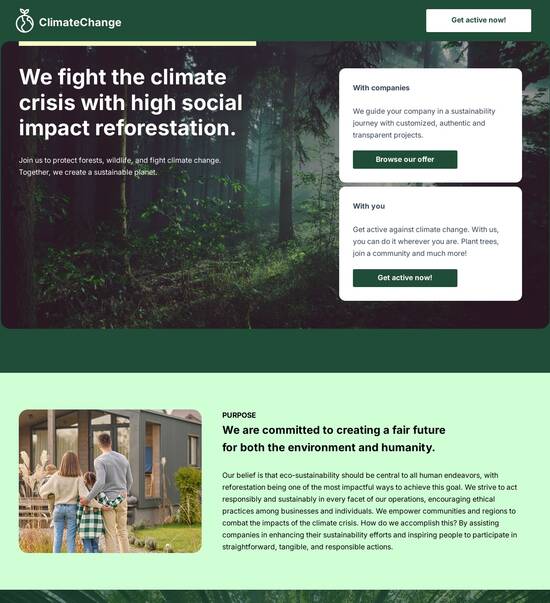
PHP optimized privacy policy page template
Explore Similar TemplatesAbout template
Supercharge your privacy policy page with PHP for outstanding performance! Learn more today.
Recommended templates

Easy to build without coding
With the intuitive drag-and-drop builder, anyone on your team can create high-converting pages without any knowledge of code or design. Make enhancements to your landing page with custom widgets using Javascript, HTML/CSS, or third-party scripts.

Multiple layouts for any industry and goal
Select from 500+ landing page layouts built to boost conversions across industry-specific scenarios. Customize them by adjusting fonts, adding images, and generating on-brand content with the AI assistant. Quickly scale with Instablocks® and Global Blocks that you can save, reuse, and update globally.

Loads fast and looks polished on any device
Every template is responsive, which means they present professionally on any device and load blazingly fast with our Thor Render Engine. You can also power them up with Google AMP technology to deliver an unparalleled mobile experience and drive higher conversions.

Robust analytics & experimentation
Get real-time updates and reporting across all your devices, showing the number of visitors, conversions, cost-per-visitor, and cost-per-lead. Launch AI-powered experiments, run A/B tests, and use heatmaps to analyze user behavior, then optimize your landing page to maximize conversions.







Easy to build without coding
With the intuitive drag-and-drop builder, anyone on your team can create high-converting pages without any knowledge of code or design. Make enhancements to your landing page with custom widgets using Javascript, HTML/CSS, or third-party scripts.
Multiple layouts for any industry and goal
Select from 500+ landing page layouts built to boost conversions across industry-specific scenarios. Customize them by adjusting fonts, adding images, and generating on-brand content with the AI assistant. Quickly scale with Instablocks® and Global Blocks that you can save, reuse, and update globally.
Loads fast and looks polished on any device
Every template is responsive, which means they present professionally on any device and load blazingly fast with our Thor Render Engine.
Robust analytics & experimentation
Get real-time updates and reporting across all your devices, showing the number of visitors, conversions, cost-per-visitor, and cost-per-lead. Launch AI-powered experiments, run A/B tests, and use heatmaps to analyze user behavior, then optimize your landing page to maximize conversions.
All the features you need to build lead-generating landing pages
Explore more featuresLearn how to build top-performing landing pages for any goal
FAQs
Leading the way in building high-performing landing pages





A step-by-step guide to mastering Instapage for optimizing landing pages
Creating and optimizing landing pages is crucial for successful digital marketing campaigns, and Instapage offers the best tools to achieve this. This guide will walk you through the essential steps to leverage Instapage, transforming your campaigns to maximize your ROI effectively.
Understanding the power of Instapage
Instapage is the most powerful landing page and CRO platform, enabling marketers to scale their efforts. With over 100 customizable templates, you can quickly create effective landing pages tailored to your audience without needing any coding skills. Instapage simplifies the page creation process while ensuring high conversion rates through its built-in optimization tools.
- Access to pre-made templates that are proven to convert: Save time and focus on your marketing strategy rather than starting from scratch.
- Intuitive page builder: Easily drag and drop elements to create stunning, responsive landing pages.
- Real-time collaboration: Work seamlessly with your team and stakeholders for fast feedback and revisions.
Step 1: Creating Your Landing Page
To begin, select one of Instapage's high-converting templates that aligns with your campaign goals. Use the drag-and-drop builder to customize the layout, incorporating your brand elements and lead generation tools for maximum impact.
Step 2: Optimizing for Conversions
Once your landing page is built, utilize Instapage's A/B testing feature to refine it. Monitor on-page user behavior with detailed heatmaps and make informed decisions to enhance your page's effectiveness.
- Conduct A/B tests to compare variations of your landing page: Identify which elements drive more conversions and adjust accordingly.
- Utilize heatmaps to understand user interactions: See where users click, scroll, and spend the most time on your page.
- Regularly check your analytics dashboard: Track your landing page's performance metrics and iterate based on actual data.
Step 3: Personalization and Targeting
Enhance your landing page's performance through personalization. By using dynamic text replacement and aligning specific ads to unique pages, you can create engaging experiences that resonate with your audience.
- Use dynamic text replacement to personalize content: Tailor messages to match the ads users clicked.
- Align ads to specific landing pages with AdMaps: Ensure a consistent message from ad to landing page for better conversion.
- Track performance metrics at the audience level: Understand what segments convert best and double down on those strategies.
Following these steps will significantly boost your conversion rates and marketing effectiveness with Instapage.
Ready to take your marketing campaigns to the next level? Sign up for Instapage today and start creating high-converting landing pages instantly!
People also ask about PHP optimized privacy policy page template
Understanding the importance of a PHP optimized privacy policy page template
Understanding the need for a privacy policy page in PHP-based websites
A privacy policy page is an essential component for any PHP-based website. With data privacy regulations like the General Data Protection Regulation (GDPR) and the California Consumer Privacy Act (CCPA) now in effect, organizations are required to inform users about how their data is collected, stored, and used. These regulations impose strict guidelines on businesses, outlining significant penalties for non-compliance. Therefore, a well-structured privacy policy not only fulfills legal obligations but also builds a foundation of trust with users.
Transparency in data handling is crucial for fostering user confidence. When users know their data is being managed responsibly, they are more likely to engage with the website and provide their information. A comprehensive privacy policy is central to this effort, detailing what types of data are collected, the purpose for collection, and how it will be protected. Furthermore, a privacy policy should clearly articulate users' rights regarding their personal data.
User's data rights under applicable laws.
Type of data collected and how it is used.
The data retention period and deletion policies.
Third-party sharing practices, if applicable.
Key features of a PHP optimized privacy policy page template
A PHP optimized privacy policy page template should incorporate several key features to ensure compliance and enhance user experience. First, dynamic content adaptation allows the template to auto-populate legal language based on the specific data practices of the website. By customizing sections to include the relevant types of data collected, such as personal details or browsing habits, the policy can remain accurate and informative. Additionally, a responsive design ensures the template displays effectively on various devices, catering to users' preferences.
Another essential feature is a user-friendly interface. The layout must be easy to navigate for both administrators updating the policy and end-users seeking information. To improve usability, include quick access links for key sections, such as user rights or data usage, along with a frequently asked questions (FAQ) area. This curated approach to information helps clarify common user concerns and makes it easier for them to understand their rights.
Auto-population of legal text based on data practices.
Customizable sections for specific data types.
Responsive design for diverse device accessibility.
Quick access links for ease of navigation.
FAQ section to address common user questions.
Benefits of utilizing a PHP optimized template
Using a PHP optimized privacy policy page template offers numerous benefits, particularly for developers and organizations. One major advantage is an efficient workflow for developers. By utilizing a template, coding time is significantly reduced as reusable components streamline the process of creating and maintaining privacy policies. Moreover, backend integrations allow for simpler updates, ensuring that all changes can be made seamlessly without extensive manual effort. Features that enhance debugging capabilities also assist in maintaining compliance with evolving legal requirements.
From a business perspective, adopting a well-structured privacy policy can also boost user engagement and trust. Investing in clear and concise communication regarding data practices fosters better user retention as individuals feel more secure sharing their information. Transparency plays a decisive role in establishing brand reputation; organizations that prioritize compliance and open communication can significantly improve how users perceive their commitment to data privacy. This proactive approach can yield a long-term impact on customer loyalty.
Reduced coding time through template reuse.
Simplified updates with effective backend integration.
Enhanced debugging capabilities for compliance maintenance.
Improved user retention through transparent policies.
Positive impact on brand reputation and customer loyalty.
Technological advantages of a PHP-based privacy policy template
The use of PHP for privacy policy templates leverages server-side scripting capabilities, providing several technological advantages. Dynamic response generation reflects user behavior, adjusting content as needed based on interactions with the site. This feature allows for tailored user experiences that can address individual preferences while ensuring the policy remains relevant to their engagement. Conditional statements can also be utilized to accommodate diverse user scenarios, enhancing the overall experience.
Furthermore, PHP includes a variety of security features essential for safeguarding sensitive information. Since privacy policies often contain details about how personal data will be handled, it's crucial to implement robust security measures to protect that information from unauthorized access or breaches. In addition, PHP templates offer seamless integration with various content management systems (CMS) and frontend frameworks, enriching the user experience by providing a cohesive presentation across different platforms.
Dynamic response generation based on user behavior.
Conditional statements for diverse user scenarios.
Embedded security features to protect sensitive information.
Compatibility with various CMS platforms for easy deployment.
Integration with frontend frameworks for enhanced experience.
Building strong community support around privacy practices
Creating a thorough knowledge base for teams working on privacy policies can significantly bolster compliance efforts. Establishing this repository involves documenting best practices, frequently asked questions, and ensuring contributions from both legal and technical experts. Keeping the knowledge base updated based on legal changes and community feedback ensures that the information is relevant and accurate, thus facilitating a culture of compliance within organizations.
Furthermore, setting up discussion forums or groups can encourage sharing insights and real-world applications of privacy policies. Collaborating with privacy advocates can enhance the clarity of policy language and could help in drafting more user-friendly layouts that promote transparency. By building a network of contributors, organizations can continuously improve their privacy practices and ensure they reflect the changing landscape of data privacy.
Developing a repository of best practices for privacy policies.
Encouraging contributions from legal and tech experts.
Regular updates based on legislative changes.
Forums or groups to share real-world applications.
Collaboration with advocates for improved policy language.
Addressing common questions in privacy policy creation
In the process of creating a privacy policy, there are common questions that many businesses encounter. First, it’s crucial to understand what data should be collected. For this, a checklist can serve as a helpful guide to identifying essential data types, including personal identifiers, payment details, and usage data. Knowing the difference between optional and mandatory information is also vital; organizations must clarify what data users must provide versus what can be voluntarily shared.
Next, understanding user rights is fundamental. A summary of users' rights under various regulations should be included, emphasizing the measures organizations take to ensure those rights can be exercised. It's important to lay out mechanisms through which users can request data access, request deletion, or opt-out of data collection. Additionally, having a strategy for ongoing compliance is essential, involving periodic reviews of privacy policies to ensure that they are up-to-date and responsive to any legislative changes.
Checklist for essential data types to collect.
Understanding mandatory vs. optional information.
Summary of user rights under relevant laws.
Detailed explanations of how users can exercise their rights.
Periodic review schedules for privacy policy updates.
Strategies for testing and previewing privacy policy pages
Testing and previewing a privacy policy page is vital for ensuring the content is clear and effective. Utilizing A/B testing can help identify the optimal wording and layout for the policy. This process involves presenting varied versions of the policy to users and analyzing their reactions to determine which version offers the most clarity and engagement. User feedback is invaluable during this phase; minor adjustments may lead to substantial improvements in understanding and trust.
Another helpful strategy involves leveraging preview features that enhance the review process. Live previews enable administrators to see how the policy appears across multiple formats, including desktop and mobile views. Implementing collaborative tools for team feedback ensures that different perspectives are considered before finalization, which can lead to a more thorough and user-friendly policy.
A/B testing for optimal policy wording and layout.
Analyzing user feedback to improve drafts.
Live previews across different formats.
Collaborative tools for team input during creation.
Case studies exemplifying the impact of a PHP optimized privacy policy
Examining real-world examples highlights the effectiveness of a PHP optimized privacy policy template. Success stories from various industries reveal that organizations that have adopted comprehensive policies report considerable improvements in compliance and user engagement. For instance, companies in sectors such as finance and healthcare, where compliance is particularly scrutinized, have shown increased trust and retention when users feel secure about their data practices. These organizations often see a direct link between transparency in policies and positive customer experiences.
Additionally, comparative analyses between traditional privacy policy implementations and PHP template-based policies indicate improvements in efficiency and user satisfaction. Time and cost metrics can illustrate the savings achieved by adopting a template approach. User satisfaction ratings often highlight how well-structured policies can streamline information dissemination, fostering an atmosphere of trust that can elevate a brand's reputation over time.
Analysis of companies improving compliance and engagement.
Data-driven outcomes on user retention and trust.
Time and cost metrics in developing policies.
User satisfaction ratings from both methods.
Future trends in privacy policy development
As the landscape of digital data privacy continues to evolve, emerging technologies are increasingly influencing privacy standards. Artificial intelligence and machine learning hold the potential to personalize privacy messages, tailoring them to individual user experiences and preferences. This advancement could make privacy policies more relevant and engaging for users, enhancing understanding and compliance.
Moreover, the rising significance of blockchain technology in securing data creates another layer of trust for users. Organizations that adopt blockchain can provide transparent, verifiable descriptions of how user data is handled, reinforcing commitment to data protection. Simultaneously, it's essential to anticipate changes in user expectations around privacy and transparency. As users become more informed about their data rights, organizations must continuously adapt policies to align with these evolving values, ensuring that user trust is maintained.
Role of AI and ML in personalizing privacy messages.
Increasing significance of blockchain in data security.
Shifts in user perceptions of privacy and transparency.
The need for continuous adaptation to user values.
Ready to skyrocket conversions?
Supercharge your ad campaigns with high-performing landing pages
Get started














